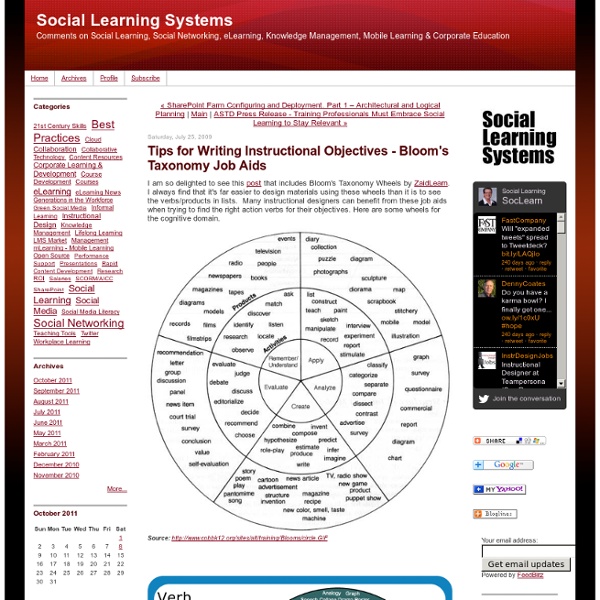



Every Student Response Strategies True implementation of personalized learning in schools requires a shift in the roles of educators and a shift in educator professional learning. This course examines the evolving role of teachers incorporating personalized learning experiences in the classroom. Taking a close look at what personalized learning is and isn’t, participants create resources to support teacher roles as facilitator, assessor, instructional designer, content curator, coach, and advisor, and family-school collaborator. Lessoncast believes in personalized professional learning. Integrating the 16 Habits of Mind In outcomes-based learning environments, we generally see three elements in play: 1) learning objectives or targets are created from given standards; 2) instruction of some kind is given; and then 3) learning results are assessed. These assessments offer data to inform the revision of further planned instruction. Rinse and repeat.
Bloom's taxonomy Bloom's wheel, according to the Bloom's verbs and matching assessment types. The verbs are intended to be feasible and measurable. Bloom's taxonomy is a classification of learning objectives within education. A Parent's Guide to 21st-Century Learning You’ll find a selection of outstanding online resources and projects, sorted by grade levels, to provide a glimpse of successful school programs. Elementary School: The World Peace Game Skype in the Classroom Peace Helpers Become Classroom Problem Solvers
Six Thinking Hats® Six Hats® ... A Critical and Creative Thinking Process that improves listening, speaking, reading and writing and is fun for ALL! Penn Hills PAGE Presentation " A special thank you to Franny for introducing me to the thinking hats and opening me up to becoming a better teacher by teaching my students to think about thinking." The Best Resources For Helping Teachers Use Bloom’s Taxonomy In The Classroom Bloom’s & SOLO ‘are not Just Colorful Posters we Hang on the Wall’ is my two-part series at Education Week Teacher. Bloom’s Taxonomy is talked about a lot in educational circles. However, if you believe a recent survey of visits to 23,000 U.S. classrooms, the higher-order thinking skills it’s ideally designed to promote doesn’t get much use. And I can understand why.
Literature Circle Models After experimenting for many years, I discovered an approach that's easy, fun, and effective. I refer to it as Classroom Book Clubs because it's a more relaxed method of doing Literature Circles that doesn't involve roles. You can view a narrated slidecast to this model by scrolling down to the Classroom Book Clubs section. On this page you can also learn about different types of Literature Circles. I've had some success with all the models below, but all models haven't been successful with all groups of students.
Ten Takeaway Tips for Teaching Critical Thinking Suggestions from educators at KIPP King Collegiate High School on how to help develop and assess critical-thinking skills in your students. Ideally, teaching kids how to think critically becomes an integral part of your approach, no matter what subject you teach. But if you're just getting started, here are some concrete ways you can begin leveraging your students' critical-thinking skills in the classroom and beyond. 1. Questions, questions, questions. Questioning is at the heart of critical thinking, so you want to create an environment where intellectual curiosity is fostered and questions are encouraged.
Bloom's Taxonomy Resources Bloom’s Taxonomy can be a powerful tool to transform teaching and learning. By design, it focuses attention away from content and instruction, and instead emphasizes the “cognitive events” in the mind of a child. And this is no small change. For decades, education reform has been focused on curriculum, assessment, instruction, and more recently standards, and data, with these efforts only bleeding over into how students think briefly, and by chance. This means that the focus of finite teacher and school resources are not on promoting thinking and understanding, but rather what kinds of things students are going to be thinking about and how they’ll prove they understand them. This stands in contrast to the characteristics of the early 21st century, which include persistent connectivity, dynamic media forms, information-rich (digital and non-digital) environments, and an emphasis on visibility for pretty much everything.
comic life Comic Life 3 is now available for both Mac and Windows! “4 Stars and Editors Choice.” MacUser Dec. 2013